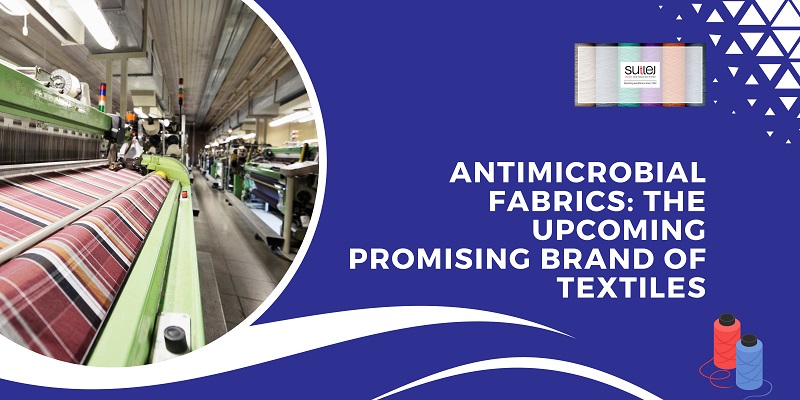Antimicrobial Fabrics: The Upcoming Promising Brand of Textiles
If you think fabrics don’t have the potential to fight off germs, then antimicrobial fabrics are here to prove you all wrong. These fabrics are a saviour in reducing the spread of illness and infection and can also help to keep fabrics looking and smelling fresh. Let’s explore antimicrobial fabrics: Also, if you are looking for a perfect end to get antimicrobial fabrics, don’t forget Sutlej Textiles: one of the best manufacturing companies in India.
What are Antimicrobial Fabrics?
Antimicrobial fabrics are fabrics treated with an antimicrobial agent to protect them from bacteria, mould, mildew, and other microorganisms. These fabrics find great use in medical and industrial settings where cleanliness is of utmost importance. Antimicrobial fabrics can also be used in everyday items such as bedding, clothing, and towels, to name a few. Antimicrobial fabrics have special coatings that help prevent the development of bacteria and microorganisms.
You Can Read Also: One step towards Most Sustainable Fabric
Uses of Antimicrobial Fabrics
The antimicrobial textiles sector will reach USD 14.7 billion by 2026, owing to rising demand across the medical and apparel industry. It is why
Textile brands in India and the world focus more on antimicrobial fabric production.
There are several reasons why antimicrobial fabrics are becoming increasingly popular. Here are five uses for these fabrics:
- Antimicrobial fabrics find applications in hospitals and other healthcare settings to help prevent the spread of infection.
- You can also find them in clothing and other personal items to help prevent body odour.
- Antimicrobial fabrics also discover use in products for people with allergies or sensitivities to help reduce the risk of reactions.
- They also use food-related products, such as aprons and tablecloths, to help prevent the growth of bacteria and mould.
- Antimicrobial fabrics have various industrial and commercial applications, such as HVAC systems and commercial kitchens.
Antimicrobial Fabric Industry & Restraints: An Overview
The antimicrobial fabric industry is highly competitive, and companies constantly seek ways to improve their products and gain market share. However, several restraints limit the growth of the industry.
One of the major restraints is the high cost of production: Antimicrobial fabrics have special materials that are expensive to produce. In addition, the manufacturing process is complex and time-consuming, which adds to the cost. As a result, antimicrobial fabrics have significantly higher prices than conventional fabrics, which limits their appeal to consumers.
Another restraint is the limited number of antimicrobial fabric applications: These have extensive use in medical and industrial settings. However, there are only a handful of other potential applications, such as sportswear and protective clothing. It limits the potential market for antimicrobial fabrics and prevents companies from diversifying their product range.
Finally, antimicrobial fabrics also face challenges from alternative products: For example, conventional fabrics treated with antimicrobial chemicals can offer similar protection at a lower cost. In addition, some synthetic fabrics are naturally resistant to bacteria and other microbes. As a result, the antimicrobial fabric industry must continue to innovate and evolve new products to stay ahead of the competition.
Antimicrobial fabrics emerged as a promising resource in Covid 19
As the Covid 19 pandemic continues to wreak havoc around the world, scientists and researchers are scrambling to find ways to contain the spread of the virus. One promising area of research is the development of antimicrobial fabrics. These fabrics are effective against various bacteria and viruses, including the SARS-CoV-2 and Influenza viruses.
The use of antimicrobial fabrics in face masks and other personal protective equipment (PPE) is an obvious choice, as these fabrics can help reduce the transmission risk. Moreover, antimicrobial fabrics are used in hospital gowns, sheets, and curtains to help create a sterile environment.
While antimicrobial fabrics are promising, more research is needed to determine their long-term efficacy against Covid 19. In the meantime, these fabrics offer a promising way to help contain the spread of the virus.
Challenges in Antimicrobial Industry
The antimicrobial fabric industry faces many challenges, including:
1. The need for effective and safe antimicrobial agents: Antimicrobial fabric industry needs more effective agents against a broad range of microorganisms, including bacteria, viruses, and fungi. Agents must also be safe for human use and not cause adverse effects.
2. Demand for durable antimicrobial fabrics: Antimicrobial fabrics need to be more durable and withstand repeated washing. They must also gain calibre to retain their antimicrobial properties for their lifespan.
3. The requirement for cost-effective antimicrobial fabrics: Antimicrobial fabrics must be cost-effective so they can be widely used and made available to those needing them.
4. The necessity for easy-to-use antimicrobial fabrics: Antimicrobial fabrics need to become easier and easily incorporated into everyday life.
5. The lack of environmentally friendly antimicrobial fabrics: Antimicrobial fabrics need more improvement to become environmentally friendly so that they do not cause any harm to the environment.
You Can Read Also: What Fabric is Best for Outdoor Furniture?
The Future of Antimicrobial Fabrics
As the world becomes aware of the dangers of antimicrobial resistance, the need for new, more effective ways to control the spread of infection is becoming more urgent. One promising area of research is the development of antimicrobial fabrics.
Antimicrobial fabrics effectively reduce the spread of infection in various settings, including hospitals, nursing homes, and daycare facilities. The use of antimicrobial fabrics is a promising new strategy for preventing the spread of infection. These fabrics have the potential to play a vital role in controlling the spread of antimicrobial resistance and protecting public health.
Bottomline
Sutlej Textiles is one of the most trusted manufacturing companies in India.
When it comes to the production of antimicrobial fabrics, with good experience in the industry, Sutlej Textiles has been able to perfect the art of producing high-quality antimicrobial fabrics suitable for a wide range of applications. Some of the most popular applications for Sutlej Textiles’ antimicrobial fabrics include medical and hygiene products, sportswear, and protective clothing.
Sutlej Textiles‘ commitment to quality and customer satisfaction is evident in everything they do. Their state-of-the-art manufacturing facility is equipped with the latest technology and led by a team of highly skilled and experienced professionals. This ensures that all its products meet the highest quality and performance standards.
If you are looking for the best antimicrobial textile brands in India, Sutlej Textiles is the company you need to connect with.



